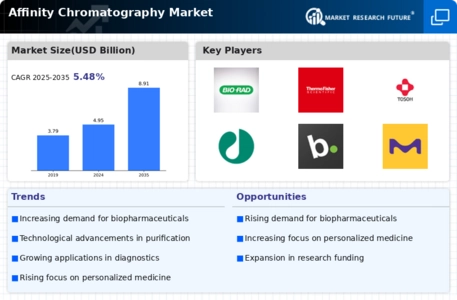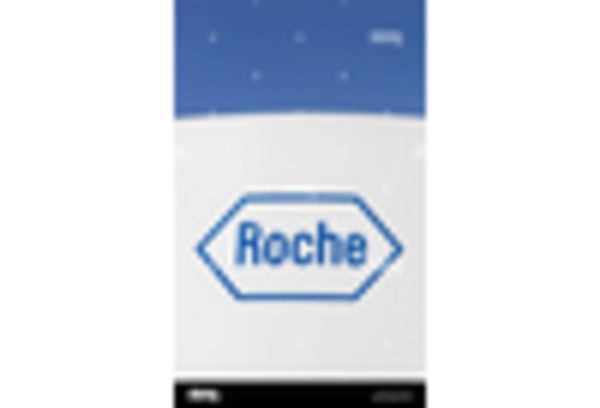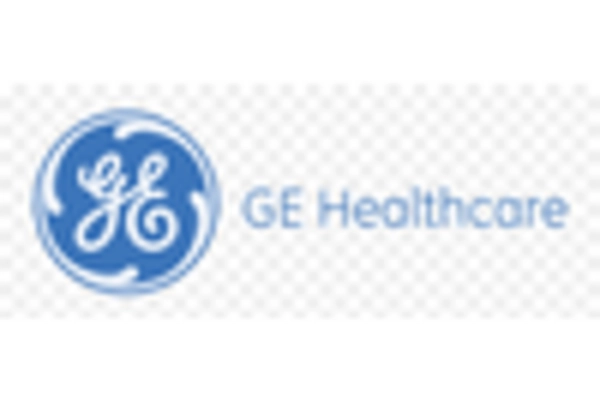Regulatory Support and Compliance
The Affinity Chromatography Market benefits from increasing regulatory support and compliance requirements in the pharmaceutical and biotechnology sectors. Regulatory bodies are emphasizing the need for stringent quality control measures in the production of biopharmaceuticals, which drives the adoption of reliable purification techniques. Affinity chromatography is recognized for its ability to meet these regulatory standards, ensuring the safety and efficacy of therapeutic products. As regulations become more stringent, companies are likely to invest in advanced chromatography solutions to maintain compliance. This trend is expected to contribute to the growth of the affinity chromatography market, as organizations seek to enhance their operational capabilities while adhering to regulatory mandates.
Rising Demand in Biopharmaceuticals
The Affinity Chromatography Market is significantly influenced by the rising demand for biopharmaceuticals, which are increasingly utilized in the treatment of various diseases. As the biopharmaceutical sector expands, the need for efficient purification methods becomes paramount. Affinity chromatography is favored for its ability to selectively isolate proteins, antibodies, and other biomolecules, which are essential in drug development. The market for biopharmaceuticals is expected to reach USD 500 billion by 2026, further propelling the demand for affinity chromatography solutions. This trend indicates a robust growth trajectory for the industry, as companies seek reliable and scalable purification technologies to meet the needs of an evolving healthcare landscape.
Growing Focus on Personalized Medicine
The Affinity Chromatography Market is increasingly shaped by the growing focus on personalized medicine, which tailors treatments to individual patient profiles. This approach necessitates the development of specific biomolecules, such as monoclonal antibodies, which require efficient purification methods. Affinity chromatography plays a crucial role in this process, enabling the isolation of high-purity products essential for personalized therapies. As the market for personalized medicine is anticipated to reach USD 2.5 trillion by 2030, the demand for affinity chromatography solutions is expected to rise correspondingly. This trend underscores the importance of chromatography in supporting the development of targeted therapies that improve patient outcomes.
Increased Research and Development Activities
The Affinity Chromatography Market is bolstered by increased research and development activities across various sectors, including pharmaceuticals, biotechnology, and academic institutions. As organizations invest in R&D to innovate and develop new therapeutic solutions, the demand for advanced purification techniques rises. Affinity chromatography is recognized for its precision and efficiency in isolating target molecules, making it a preferred choice in laboratories. The global investment in R&D is projected to exceed USD 2 trillion by 2025, indicating a favorable environment for the affinity chromatography market. This influx of funding is likely to stimulate advancements in chromatography technologies, thereby enhancing their application in diverse research fields.
Technological Advancements in Affinity Chromatography
The Affinity Chromatography Market is experiencing a surge in technological advancements that enhance the efficiency and effectiveness of separation processes. Innovations such as high-throughput screening and automated systems are streamlining workflows, thereby reducing time and costs associated with purification. The introduction of novel ligands and resins is also improving specificity and yield, which is crucial for applications in biopharmaceuticals. As a result, the market is projected to grow at a compound annual growth rate (CAGR) of approximately 8% over the next few years, driven by these advancements. Furthermore, the integration of artificial intelligence and machine learning in chromatography systems is likely to optimize operational parameters, leading to better outcomes in research and production settings.


















Leave a Comment